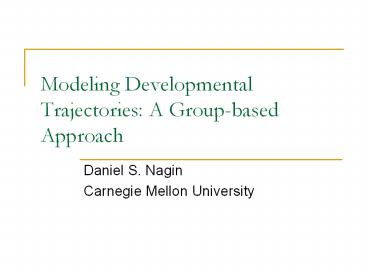Modeling Developmental Trajectories: A Group-based Approach - PowerPoint PPT Presentation
1 / 37
Title:
Modeling Developmental Trajectories: A Group-based Approach
Description:
Title: Modeling Developmental Trajectories: A Semi-parametric, Group-based Approach Author: Daniel Nagin Last modified by: dn03 Created Date: 5/5/2005 9:30:33 PM – PowerPoint PPT presentation
Number of Views:263
Avg rating:3.0/5.0
Title: Modeling Developmental Trajectories: A Group-based Approach
1
Modeling Developmental Trajectories A
Group-based Approach
- Daniel S. Nagin
- Carnegie Mellon University
2
What is a trajectory?
A trajectory is the evolution of an outcome over
age or time. (p.1) Nagin. 2005. Group-Based
Modeling of Development, Harvard University Press
3
(No Transcript)
4
Montreal Data
- 1037 Caucasian, francophone, nonimmigrant males
- First assessment at age 6 in 1984
- Most recent assessment at age 17 in 1995
- Data collected on a wide variety of individual,
familial, and parental characteristics,
behaviors, and psychopathologies
5
4
28
52
16
6
Important Capabilities of Group-based Trajectory
Modeling
- Identify Rather Than Assume Groups of Distinctive
Developmental Trajectories--Avoids
over/under-fitting of data - Estimation of Proportion of Population by
Trajectory Group - Identification of Distinctive Characteristics of
Trajectory Groups
7
Motivation for Group-based Trajectory Modeling
- Testing Taxonomic Theories
- Identifying Distinctive Developmental Paths in
Complex Longitudinal Datasets - Capturing the Connectedness of Behavior over Time
- Transparency in Efficient Data Summary
- Responsive to Calls for Person-based Methods of
Analysis
8
Trajectory Estimation Software
- Easy-to-Use, STATA and SAS-based Procedure
- Handles Missing Data (including exposure time for
count data) - Handles Sample Weights
- Does not Require Regular Time Spacing of
Measurements - Accommodates over-lapping cohort designs
- Provides confidence intervals on trajectory
estimates - Conducts Wald tests of coefficient differences
- Available www.andrew.cmu.edu/user/bjones/index.htm
9
The Likelihood Function
10
Identification of Distinctive Developmental
Trajectories An Illustrative Example
Adolescent onset (50)
Adolescent limited (50)
crime
Pop. Total
age
11
Types of Data
- Psychometric scales--Censored Normal (Tobit)
Model - Count Data--Poisson-based Model
- Binary Data--Logit-based Model
12
Linking Age to Behavior
13
Zero-inflated Poisson Model for Count Data
14
(No Transcript)
15
(No Transcript)
16
Logit Model for Binary Data
where y1 if yes y0 if no
17
Trajectories of Delinquent Group
Membership(Development Psychopathology, 2003)
18
Topics for Discussion
- Profiling Trajectory Group Members
- Measuring the Effect of Individual
Characteristics on Probability of Trajectory
Group Membership - Adding Covariates to the Trajectory Itself
- Dual Trajectory Modeling
- Groups as an approximation
- Group-based Modeling v. Growth Curve Modeling
19
Calculation Use of Posterior Probabilities of
Group Membership
Maximum Probability Group Assignment Rule
20
Group Profiles
21
Other Uses of Posterior Probabilities
- Computing Weighted Averages That Account for
Group Membership Uncertainty - Diagnostics for Model Fit
- Matching People with Comparable Developmental
Histories
22
Statistically Linking Group Membership to
Individual Characteristics
- Moving Beyond Univariate Contrasts
- Group Identification is Probabilistic not Certain
- Use of Multinomial Logit Model to Create a
Multivariate Probabilistic Linkage
23
Risk Factors for Physical Aggression Trajectory
Group Membership
- Broken Home at Age 5
- Low IQ
- Low Maternal Education
- Mother Began Childbearing as a Teenager
24
(No Transcript)
25
Model Extensions
- Entering Covariates into the Trajectory Itself
- Joint Trajectory Analysis
- Multi Trajectory Modeling
26
Does School Grade Retention and Family Break-up
Alter Trajectories of Violent Delinquency
Themselves?(Nagin, 2005 Development and
Psychopathology 2003)
27
The Overall Model
Z1 Z2 Z3
Z4 Z5 . . Zm
Probability of Trajectory Group Membership
Trajectory 1 Trajectory 2 Trajectory
3 Trajectory 4
X1t X2t X3tXlt
28
Model of Impact of Grade Retention and Parental
Separation on Trajectory Group j
Model without retention or separation impact
Trajectory with retention and separation impacts
29
(No Transcript)
30
Dual Trajectory Analysis Trajectory of Modeling
of Comorbidity and Heterotypic Continuity
31
Modeling the Linkage Between Trajectories of
Physical Aggression in Childhood and Trajectories
of Violent Delinquency in Adolescence
32
Transition Probabilities Linking Trajectories in
Adolescent to Childhood Trajectories
Trajectory in Adolescence
Low 12 Rising Declining Chronic
Low .889 .092 .019 .000
Declining .707 .136 .128 .029
High .422 .215 .206 .158
Trajectory in Childhood
33
Multi-Trajectory Modeling
34
Linking Trajectories to Later Out
ComesTrajectories of Physical Aggression from 6
to 15 and Sexual Partners at 17
35
Using Groups to Approximate an Unknown
Distribution
36
Implications of Using Groups to Approximate a
More Complex Underlying Reality
- Groups are not immutable
- of groups will depend upon sample size and
particularly length of follow-up period - Search for the True Number of Groups is a
Quixotic exercise - Groups membership is a convenient statistical
fiction, not a state of being - Individuals do not actually belong to trajectory
groups - Trajectory group members do not follow the
group-level trajectory in lock-step
37
Group-Based Trajectory Modeling Compared to
Conventional Growth Curve Modeling (HLM)
- Common point of departure both model individual
level trajectories by a polynomial equation in
age or time - Point of departure how to model individual-
level differences in developmental trajectories
(e.g., population heterogeneity) - HLM use normally distributed random effects
- Group-based trajectory modeling approximates an
unknown distribution of individual differences
with groups































